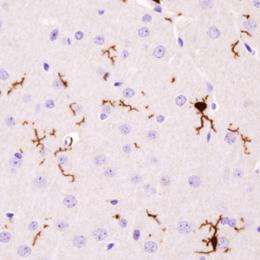Key signal prepares immune cells to defend skin, brain

(Medical Xpress) -- Scientists at Washington University School of Medicine in St. Louis have identified the molecular signal that triggers the development of immune cells that patrol the skin and brain.
Both the immune cells that protect the skin, called Langerhans cells, and those that protect the brain, called microglia, have specialized features that make them better defenders of their respective territories. Researchers now report in Nature Immunology that the cells only acquire those characteristics after they bind to an immune system molecule known as IL-34.
“We found that IL-34 is an essential growth factor for the differentiation of Langerhans cells and microglia during embryonic development,” says senior author Marco Colonna, MD, professor of medicine and of pathology and immunology. “We also showed that some of the biggest producers of IL-34 are neurons and skin cells known as keratinocytes. What we’re learning will help us better understand how Langerhans cells and microglia protect against infection and their roles in autoimmune conditions.”
Because most immune cells typically can’t get into the brain, microglia are adapted to perform multiple functions that are normally handled by several different types of immune cells. Langerhans cells have adaptations that help call the immune system’s attention to infections entering via the skin.
Both Langerhans cells and microglia begin life as immune stem cells. Scientists had previously identified a receptor expressed on those cells and an immune molecule that binds to the receptor, causing the stem cells to become macrophages, a common type of immune cell. More recent evidence has shown that another immune molecule, IL-34, also binds to the same receptor. This redundancy made Colonna and his colleagues suspicious that IL-34 might be doing something different.
In the new study, the scientists genetically engineered mice that did not make IL-34. The mice had very few Langerhans cells and microglia, and were also much more vulnerable to skin and brain infections.
Scientists also found evidence of IL-34 production in the kidney and testis. Immune cells that specialize in defending these areas may get some prompting from IL-34, the researchers speculate, but the numbers of these cells were not significantly reduced when IL-34 was knocked out, suggesting that other molecules can perform the same function for those cells.
Colonna notes that microglia, Langerhans cells and other immune cells are responsible both for attacking invaders and for cleaning up and rebuilding after a conflict. Some tumors may take advantage of the latter ability to create new blood vessels that support their ability to grow.
“We want to see if brain tumors and skin tumors have high levels of IL-34,” he says. “If this is so and we can use drugs to block IL-34, that may help limit tumor growth.”
In addition to their immune functions, microglia are also involved in the elimination of unnecessary neurons and neuronal branches during early development of the brain.
“These functions of microglia may come into play during developmental disorders like autism or neurodegenerative disorders like Alzheimer’s,” says first author Yaming Wang, a graduate student. “For example, there’s some debate over whether microglia help or harm the brain in Alzheimer’s. These new mice may help settle that debate.”
More information: Wang Y, Szretter KJ, Vermi W, Gilfillan S, Rossini C, Cella M, Barrow AD, Diamond MS, Colonna M. IL-34 is a tissue-restricted ligand of CSF1R required for the development of Langerhans cells and microglia. Nature Immunology, July 29, 2012. doi: 10.1038/ni.2360














